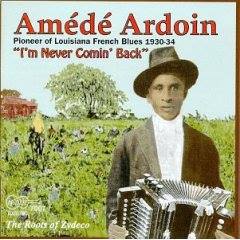This post was contributed by Mr. Alex Lee who has been researching his Saint Landry parish Louisiana family for many years and, as he discovered the interconnectedness of the St. Landry families, branched out to research many other families of the parish. He continues to delight us with stories of the Creole culture from the country parish of St. Landry.
Idé Ardoin, better known as “Amede Ardoin” was born on the 11th day of March 1898 in the rural community of Chataignier, outside of Eunice, in Evangeline Parish [carved out of St. Landry parish in 1910]. Amede was the youngest son of Thomas Francois Ardoin, alias “Thomas BUSHNELL” and Aurelia Clintz, “un esclave mulâtre de la famille B Fontenot.” Amede is known as the person who crystalized Louisiana Creole Zydeco music and much of this style of music has been an extension of what he created. Even during the time of racial segregation it still didn’t stop Amede from playing for white crowds which eventually resulted in his tragic death.
[Historical Note: While playing his accordion at a local farmhouse in Eunice, Louisiana, in the late 1930s, Creole musician Amede Ardoin wiped his brow with a handkerchief given to him by a white woman. Two white men angered by the exchange between Ardoin and the woman followed him outside, where they beat him, backed over him with a Ford Model A truck and threw him in a ditch. He woke up crippled, with permanent brain damage. Watch this short video to get the story https://www.youtube.com/watch?v=WyIbUD5_7Ko ]
A few Zydeco artists such as Chris Ardoin, his father Black Ardoin, Grandfather Boi Sec Ardoin, and Kieth Frank can all trace their ancestry to the same Ardoin family. Amede died on the 3rd day of November 1942 at a mental asylum in Pineville, Louisiana.
[Historical Note: “(In the summer of 2013), the search for Amédé Ardoin seemed to have hit its final dead end. Lawrence Ardoin, a descendant of the legendary Creole accordionist, was working with officials at the state mental institution in Pineville to erect a statue in Amédé’s honor.
But Ardoin is one of 2,469 patients buried in unmarked graves on the hospital grounds. With no way to know which grave holds Amédé, Lawrence Ardoin was giving up.
But the effort to memorialize Amédé (was revived in 2014) with a fundraising effort to build a public memorial to Ardoin in his hometown of Eunice. This new project boost(ed) an everlasting fascination with Ardoin’s music, life and influence. In the 1920s and ’30s, Ardoin and fiddler Dennis McGee recorded French waltzes and two steps that planted the seeds for Cajun music and zydeco.
Although he was unable to read and write, Ardoin developed a complex and moving accordion style that few can imitate today. His songs of loneliness, heartache and life as an orphan made women break down in the dancehall.]
Amede Ardoin left no children but left a behind a lasting legacy of the popular Louisiana Creole Zydeco music.
Sources: “The Last Trace of Amede Ardoin,” by Joe Kloc, http://www.motherjones.com/mixed-media/2011/03/amede-ardoin-cajun-zydeco-mardi-gras; “The Death of Amede Ardoin,” https://www.youtube.com/watch?v=WyIbUD5_7Ko ; “Search for Amédé Ardoin Gains New Life,” http://www.theadvertiser.com/story/entertainment/music/2014/08/07/search-amd-ardoin-gains-new-life/13709269/
Lenora Gobert (providing additional historical information)




Excellent piece. Concise and informative. The link to the video is a welcome touch.